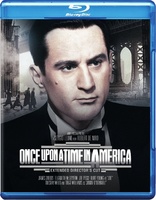Once Upon a Time in America Blu-ray Movie
HomeOnce Upon a Time in America Blu-ray Movie 
Extended Director's CutWarner Bros. | 1984 | 251 min | Rated R | Sep 30, 2014
Movie rating
8.4 | / 10 |
Blu-ray rating
| Users | 4.2 | |
| Reviewer | 4.5 | |
| Overall | 4.2 |
Overview
Once Upon a Time in America (1984)
Drama about the rise and fall of a group of Jewish gangsters in New York at the beginning of the century through the 1960s.
Starring: Robert De Niro, James Woods, Elizabeth McGovern, Joe Pesci, Burt YoungDirector: Sergio Leone
| Drama | 100% |
| Crime | 47% |
| Period | 41% |
| Epic | 24% |
Specifications
Video
Video codec: MPEG-4 AVC
Video resolution: 1080p
Aspect ratio: 1.79:1
Original aspect ratio: 1.85:1
Audio
English: DTS-HD Master Audio 5.1 (48kHz, 24-bit)
French: Dolby Digital 5.1 (640 kbps)
German: Dolby Digital 5.1 (640 kbps)
Italian: Dolby Digital 5.1 (640 kbps)
Spanish: Dolby Digital 5.1 (640 kbps)
Spanish: Dolby Digital 2.0
Japanese: Dolby Digital 5.1
Spanish 2.0=Latin; Japanese is hidden
Subtitles
English SDH, French, German SDH, Italian SDH, Japanese, Spanish
Discs
50GB Blu-ray Disc
Single disc (1 BD)
Playback
Region free
Review
Rating summary
| Movie | 5.0 | |
| Video | 3.5 | |
| Audio | 4.0 | |
| Extras | 1.0 | |
| Overall | 4.5 |
Once Upon a Time in America Blu-ray Movie Review
Dreaming Even More Deeply
Reviewed by Michael Reuben September 28, 2014Sergio Leone's 1984 masterpiece, Once Upon a Time in America (hereafter, "OUATIA")—part gangster epic, part memory play, part mystery story and part history elevated into myth—has been extended by some twenty-two minutes of footage long thought to be lost. Before anyone gets too excited, it should be noted that the restored scenes have been taken from less than ideal sources. Despite the best efforts of L'Immagine Ritrovata and the Cineteca di Bologna (working from scans made by Warner Brothers' MPI), the newly integrated material is easy to spot for its lesser quality. Nevertheless, the added scenes fill in crucial narrative gaps and deepen our understanding of key supporting characters who have always felt slighted in the existing 229-minute cut. For anyone who loves OUATIA, or who simply appreciates cinematic storytelling on a grand scale as no one but Leone could do it, a few steps down in quality is a minor sacrifice just to have these scenes restored to their rightful place. Warner Home Video is releasing this "extended director's cut" of OUATIA in two editions, a single disc containing the 251-minute new version and a two-disc Collector's Edition that includes the previous release (without the new scenes) plus an illustrated book with notes on the restoration and other materials. Because WHV provided only a screener of the single-disc edition prior to street date, this review focuses solely on the new scenes. For discussion of the previous release and OUATIA in general, please see my colleague Jeff Kauffman's detailed Blu-ray review of the previous edition.
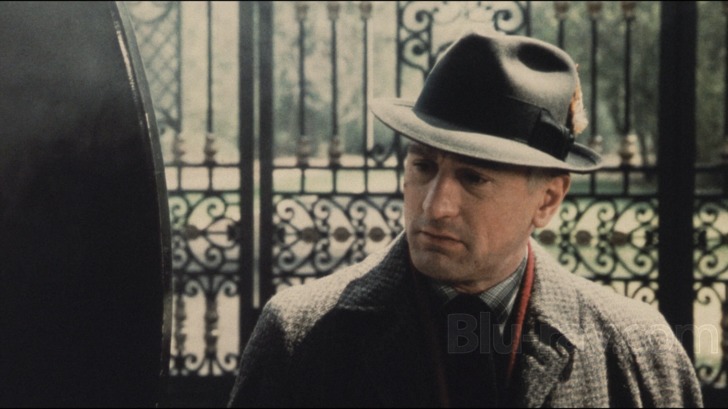
One cannot discuss the new scenes without addressing their context in the larger scheme of OUATIA, which means that the following discussion assumes the reader is already familiar with the film and makes no effort to avoid spoilers for first-time viewers. This will be the only warning provided. A key supporting character who always seemed underdeveloped in the existing version of OUATIA is Darlanne Fluegel's Eve, who becomes the girlfriend of "Noodles" Aaronson (Robert De Niro) after he and his childhood love, Deborah (Elizabeth McGovern), break each other's hearts. In the film's fractured time line, Eve makes a dramatic entrance that is followed very closely by her death at the hands of gangsters looking for Noodles. When Noodles returns later that evening and finds Fat Moe (Larry Rapp) bleeding on the floor of his speakeasy, he makes it clear that he cares enough for Eve that he wants to find her before he flees the city. (Moe delivers the bad news that Noodles' pursuers got to her first.) But when the film flashes back to the complex events leading up to this cataclysmic night, Eve is simply there. We don't know where she came from. In a scene that now begins at around 2 hours, 48 minutes (Chapter 18), we find out. After Noodles' disastrous date with Deborah, he is drinking himself into a stupor when Eve approaches him in a bar. Like most of the women in these gangsters' lives, she's a hooker, but she and Noodles spend an unusual night together, in which the remorseful kingpin pays Eve an exorbitant fee to answer to the name of "Deborah". He awakens in the morning to find a note with her phone number, then rushes to the train station for a last glimpse of the real Deborah as she departs (a scene that exists in the prior version). The sequence not only acts as an introduction for Eve, but it also makes the horrible conclusion to the previous evening's date even more tragic, as an incoherent Noodles tries to lavish on another woman the tenderness he wanted to offer Deborah, to whom he ended up showing only violence. The date with Deborah is also preceded by a short additional scene, at 2 hours, 34 minutes, in which Noodles and the chauffeur driving the limousine exchange a few words while waiting for Deborah. (The chauffeur is played by the film's producer, Arnon Milchan.) The scene gives greater heft to the moment when Noodles steps out of the limousine at dawn on Long Island and tells the chauffeur to take Deborah home. The chauffeur's wordless reaction is not just born of recent events; indeed, those events have simply confirmed the chauffeur's initial assessment of the man who hired him. The most extensive additions occur in the 1968 portion of the film and concern the mystery of why Noodles was summoned back to New York City and by whom. When he visits the lavish mausoleum built for the three comrades who died thirty-five years ago, where a key hangs next to a plaque stating that he built the memorial, he now meets (at about 1:34:50) a cemetery director played by Louise Fletcher who talks to him about the man who claimed to be him. Noodles also spots a dark car with tinted windows that appears to have followed him and that takes off when he tries to approach it. Later (at 2:09:40), Noodles will see this car again at the Long Island residence where he has been invited to a party; he recognizes it by its license plate as it leaves the gated driveway, and then it suddenly explodes. The event is followed by a TV news report of the explosion, which kills a district attorney, and was included in the previous version of OUATIA, because it provides essential exposition about the developing scandal involving Secretary of Commerce Christopher Bailey. The infamous and much-debated scene near the end of the film where Noodles watches a garbage truck start up and drive away from Secretary Bailey's home is not made any less ambiguous by the added scenes, but Leone foreshadowed it more thoroughly than is evident from the existing cut. In the scene in the Thirties where Noodles impulsively drives the gang's car into the bay (in part as a reminder that they're still just kids from Brooklyn playing at being gangsters), the scene continues (at 2:07:30) with Max (James Woods), Patsy (James Hayden) and Cockeye (William Forsythe) bobbing in the water looking for Noodles while a huge dredging barge operates behind them. The scene then dissolves to the chopping mechanism of a garbage truck in 1968 at which Noodles is staring outside the Long Island mansion of Secretary Bailey. Later, when he sees a similar truck outside the Secretary's home, it is not the novelty that it now appears to be in the existing cut. The threat to the Secretary's life is an explicit topic of discussion in what is perhaps the most substantive of the added scenes, a long conversation between Secretary Bailey and Jimmy "Clean Hands" O'Donnell (Treat Williams) that occurs at 3:41:40 during the party at the Secretary's home. The scene falls between the first time the Secretary appears in the film (at the window of his study watching arriving guests) and Noodles' entrance in response to his invitation, and it accomplishes several goals. First, it completes the arc of Jimmy "Clean Hands" from his first appearance as an idealistic union boss to his final incarnation as a cold-blooded hoodlum. Second, it creates even greater uncertainty about what happens in the later scene with the garbage truck. (If you listen to Jimmy's dialogue, he sounds like he doesn't expect any attempt to be made on the Secretary's life that evening.) And third, the scene provides further insight into the nature of the Secretary's "legal" problems. One further addition is worth noting. Noodles' reunion with Deborah in 1968 is one of OUATIA's most quietly devastating scenes, but it has always seemed to arrive somewhat abruptly after Noodles' discovery that Deborah is "the patron saint" of the Bailey Foundation. Now an additional scene precedes it at 3 hours, 28 minutes (Chapter 22), where Noodles sits in the audience, watching Deborah on stage playing the lead in Shakespeare's Antony and Cleopatra, thus belatedly accepting the invitation she gave him to come watch her perform when he was released from prison many years ago. It's an effective setup to the moment when this ghost from Deborah's past appears in her dressing room as she is removing her mask-like makeup and becoming herself again, vulnerable now so that she has no defense when a young man named David knocks on the door. In sum, the new scenes deepen and enrich an already extraordinary film, and while they may not be considered "essential" (in the sense that the film doesn't stand or fall on their inclusion), OUATIA is certainly better with them than without them. The fact that high-quality source materials could not be found is unfortunate, but the restoration wizards have done a remarkable job with what amounted to discards. Not long ago, these scenes could not have been rescued in any form.
Once Upon a Time in America Blu-ray Movie, Video Quality 
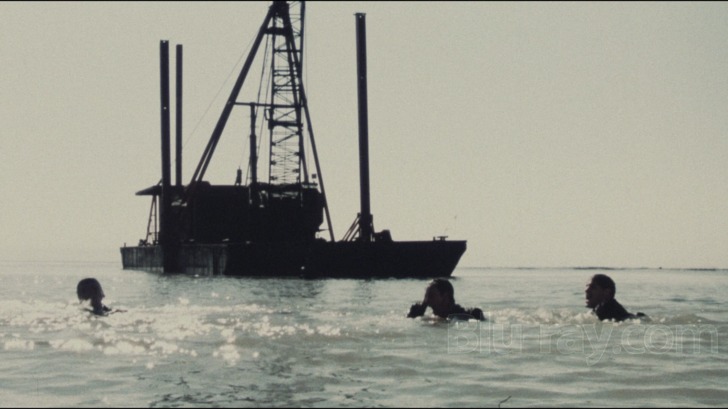
All screenshots accompanying this review are taken from the newly added scenes. An introductory title card for the Restored Director's Cut of Once Upon a Time in America provides the following "Restoration Note":
The main challenge of this restoration was putting the missing scenes back into the film. These scenes, which Sergio Leone had to cut and were previously considered lost, were inserted into this extended version in the most harmonious way possible. Unfortunately, the only materials available were discarded strips of working positives which were printed for reference only. Part of the restoration work included improving the quality of these missing scenes so that they could be re-integrated into the film as seamlessly as possible. The resulting version brings us closer to the filmmaker's original vision for the film. Documents and testimony from Sergio Leone's family and collaborators were essential for the reconstruction of this extended version.Given these limitations, the usual criteria applied in a Blu-ray review are largely irrelevant. The screen captures included with this review have all been taken from the added scenes, and a comparison with captures from the previous version of OUATIA provided in Jeff Kauffman's review will immediately reveal the difference. The restored material is frequently washed out and lacking in fine detail. Colors are often weak (though not always), and contrast and black levels are often so poor that, especially in darker scenes, only the main action is visible. Digital tools have repaired any obvious damage, but even the most advanced processing cannot supply detail that wasn't there to begin with. A transfer from negative that resulted in such an image would be condemned and rightly so. Here, however, one is simply grateful that the scenes are viewable at all. By dropping the Richard Schickel commentary (which would not cover the new material), as well as several audio and subtitle options, Warner saved enough digital real estate to achieve roughly the same average bitrate for this new version of OUATIA as for the previous edition (14.98 Mbps for the new disc vs. 14.96 for the old). Compression artifacts are not in evidence, but it would be interesting to see how OUATIA would look spread over two discs and allowed greater bandwidth.
Once Upon a Time in America Blu-ray Movie, Audio Quality 
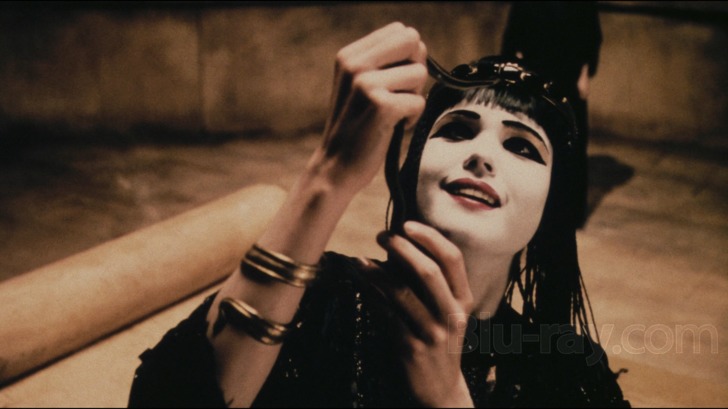
OUATIA was originally released in mono. The 5.1 remix presented on Blu-ray in lossless DTS-HD MA was done for Warner's 2003 two-disc DVD. The restoration team worked closely with various consultants, including composer Ennio Morricone, to incorporate the additional sequences with as little disruption as possible to the film's sonic flow, and the results are remarkable. To my ear, the only obvious difference in the added scenes was a hollowness to the actors' voices that occasionally rendered a word or two difficult to understand. Otherwise, the sound flowed smoothly. In a film where the score is such an essential element tying together three separate time periods, harmonizing the soundtrack goes a long way toward overcoming the visual limitations of the new scenes.
Once Upon a Time in America Blu-ray Movie, Special Features and Extras 
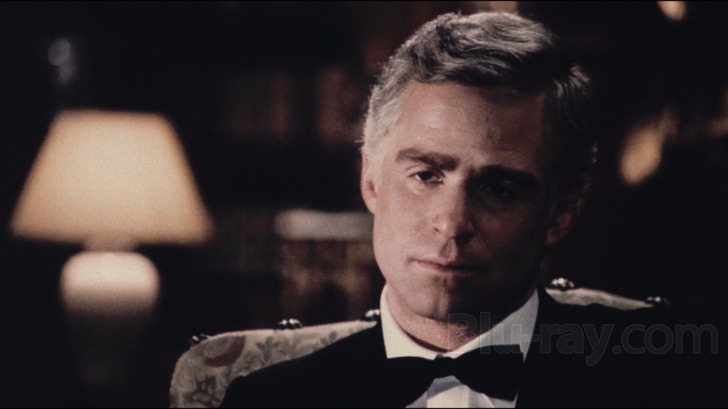
The extras consist of the previously included excerpt from the documentary Once Upon a Time: Sergio Leone (480i; 1.78:1, enhanced; 19:36), as well as a Teaser Trailer (480i; 1.78:1, enhanced; 1:34) and a Theatrical Trailer (480i; 1.78:1, enhanced; 2:39).
Once Upon a Time in America Blu-ray Movie, Overall Score and Recommendation 
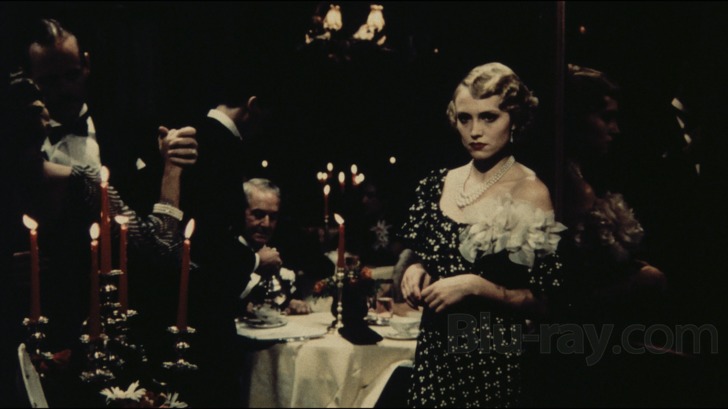
It is unfortunate that Warner chose not to provide the Collector's Edition of OUATIA for early review, because that would have allowed me to comment on the much-discussed changes in the new disc's presentation of the 229 minutes of scenes carried over from the previous release, as well as describing the contents of the included volume of memorabilia and information. However, standing on its own, the extended director's cut of OUATIA is a must-have for fans of the film, and anyone who already owns the previous version and doesn't care about books and collectibles should at least acquire the single-disc version. The film remains one of cinema's great achievements. Highly recommended.
Other editions
Once Upon a Time in America: Other Editions
Similar titles
Similar titles you might also like

The Godfather: Part II 4K
1974

The Godfather 4K
1972

Live by Night
2016

GoodFellas 4K
1990

The Irishman
2019

Boardwalk Empire: The Complete First Season
2010

Casino 4K
1995

Little Caesar
1931

There Will Be Blood
2007

The Godfather: Part III
1990

City of God
Cidade de Deus
2002

The Public Enemy
1931

Billy Bathgate
1991

Carlito's Way 4K
1993

The Roaring Twenties 4K
1939

Road to Perdition
2002

Donnie Brasco
Extended Cut
1997

Citizen Kane
75th Anniversary Edition
1941

A Most Violent Year
2014

King of New York
1990
